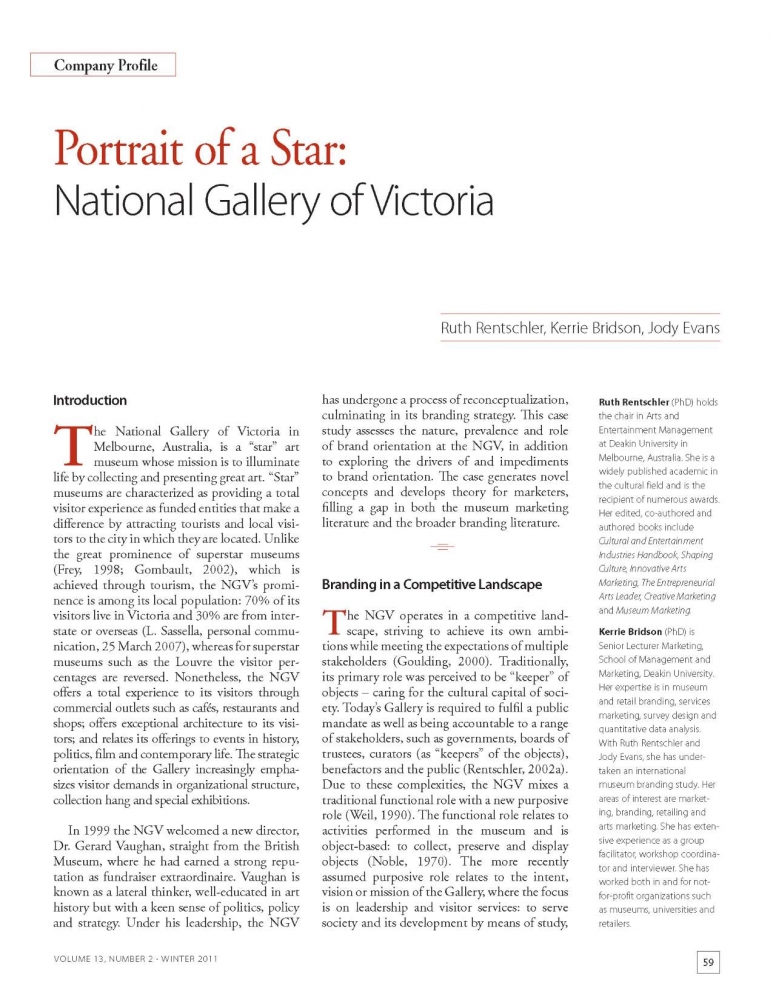Portrait of a Star: National Gallery of Victoria
Produit: Article
21,00 $ CA
Ruth Rentschler, Kerrie Bridson, Jody Evans
Ruth Rentschler (PhD) holds the chair in Arts and Entertainment Management at Deakin University in Melbourne, Australia. She is a widely published academic in the cultural field and is the recipient of numerous awards. Her edited, co-authored and authored books include Cultural and Entertainment Industries Handbook, Shaping Culture, Innovative Arts Marketing, The Entrepreneurial Arts Leader, Creative Marketing and Museum Marketing.
Kerrie Bridson (PhD) is Senior Lecturer Marketing, School of Management and Marketing, Deakin University. Her expertise is in museum and retail branding, services marketing, survey design and quantitative data analysis. With Ruth Rentschler and Jody Evans, she has undertaken an international museum branding study. Her areas of interest are marketing, branding, retailing and arts marketing. She has extensive experience as a group facilitator, workshop coordinator and interviewer. She has worked both in and for not-for-profit organizations such as museums, universities and retailers.
ABSTRACT
Museums are an important segment of the creative industries arena. A “star” art museum in Melbourne, Australia, is the National Gallery of Victoria, whose mission is to illuminate life by collecting and presenting great art. This gallery operates in an increasingly competitive landscape. It is becoming more competitive and is continuously striving to achieve its own ambitions and meet the expectations of multiple stakeholders. The present case study uses a brand orientation lens to evaluate the Gallery in order to address a gap in both the brand orientation and the museum marketing literature. It is crafted from interviews, surveys and internal documents. The case study is an exemplar for other institutions to identify how brand orientation manifests itself within their institution.
KEYWORDS
National Gallery of Victoria, branding, brand orientation, museum marketing
RÉSUMÉ
Les musées constituent un segment important de l’arène des industries de la création. La National Gallery of Victoria, à Melbourne (Australie), est un musée d’art « star » qui s’est donné pour mission d’illuminer l’existence en rassemblant et en exposant de grandes œuvres d’art. Existant dans un contexte de plus en plus concurrentiel, il devient lui-même plus concurrentiel et lutte constamment pour réaliser ses ambitions et répondre aux attentes de ses multiples parties prenantes. cette étude de cas évalue la Gallery à travers la lentille de l’orientation stratégique pour aborder l’écart entre la littérature sur l’orientation stratégique et celle sur le marketing des musées. Elle se base sur des entrevues, des sondages et des documents internes. Les résultats pourront aider d’autres institutions à découvrir comment se manifeste l’orientation stratégique dans leur cadre.
MOTS CLÉS
National Gallery of Victoria, branding, orientation stratégique, marketing d’un musée
RESUMEN
Los museos constituyen un importante segmento de las industrias creativas. A la National Gallery of Victoria se le considera una “estrella” entre los museos de arte de Melbourn, Australia. Su misión: iluminar la vida coleccionando y presentando gran arte. Este museo opera en un contexto de creciente competencia, lo que la ha llevado a ser cada día más competitivo y a esforzarse continuamente por satisfacer las expectativas de los múltiples interesados. El presente caso se estudia a través del lente de la orientación hacia la marca para evaluar la National Gallery con miras a colmar un vacío tanto en la orientación hacia la marca como en las publicaciones de marketing. El estudio de caso se ha hecho a partir de entrevistas, encuestas y documentos internos y puede servir de ejemplo para identificar cómo se manifiesta la orientación hacia la marca en otras instituciones.
PALABRAS CLAVE
National Gallery of Victoria, imagen de marca, orientación hacia la marca, marketing de museos

